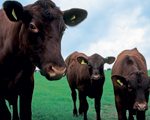Britain's best steak
Country Life conducted a British beef tasting at the restaurant of Mark Hix and found British beef to be varied, tasty, local and easy to get from your butcher.


Country Life’s British beef tasting session was a celebration of a unique heritage. Every piece of meat we judged was delicious and a telling advertisement for our traditional British breeds, as well as the traditional methods used to rear them. It was a difficult but enjoyable task. There are a number of reasons why beef produced from British breeds is exceptional. First, our cattle and, indeed, sheep spend most of their lives out of doors, feeding on a diet of grass, grass products and a limited amount of concentrates, often homegrown. Research suggests (and diners know) that grass-fed beef tastes better. Traditional breeds also have increased marbling of fat, which melts into the meat during cooking and gives it a better flavour. Treatment at slaughter is another factor.
If animals are stressed before slaughter, the meat becomes tough. Short journeys to the local abattoir equal less stress for the animal, fewer ‘food miles’ and better meat. Likewise, proper maturing is vital, and all the contestants’ beef had been hung on the bone for at least two to three weeks before we tried it. This contrasts to animals destined for supermarkets, which often travel long distances to slaughter; very little of their meat is hung and treated with the care it receives at the smaller meat plants and butchers. Another argument in Britain’s favour is that animals reared extensively on grass produce less methane (a greenhouse gas) and don’t require the same amount of concentrates, which have both an economic and an environmental cost.
Our grazing livestock provide us with wonderful meat, but they have a much wider significance. They are the guardians of our landscape. The mosaics of small fields, downland, heathland, fells, salt-marshes and most of our wildlife reserves all have to be grazed to maintain their beauty and biodiversity. Without livestock, they would revert either to arable cultivation or become abandoned thickets.
Livestock are at the heart of the local food economy. It’s almost impossible to run a farm shop or farmer’s market without a local meat supply. Butchers rely on the superior quality of the meat they sell to differentiate themselves from the majority of supermarkets, and they are often the only independent shops left in our market towns. Pubs and restaurants also rely on quality local meat.
Although much of our food heritage has disappeared, we still have our traditional British meat. But even that is under threat from supermarket pressure for greater uniformity of product, which is geared to the size of supermarket packaging, from the burden of increasing costs and from the increasing regulation which affects farmers, abattoirs and butchers.
In these difficult economic times, we can play a very real part in guaranteeing the survival of our British breeds, our local food economies, our landscape and our countryside by buying British beef. When you eat out or go shopping, ask where the meat came from and the name of the breed. If you can, buy it from your butcher, who can give you expert advice. By doing this, we all can make a difference and eat very well indeed.
The winner: The Longhorn
Exquisite houses, the beauty of Nature, and how to get the most from your life, straight to your inbox.
THE LONGHORN, which originated from Craven, northern England, became popular in the 18th century when Robert Bakewell used selective breeding methods to refine it. Longhorns are docile, able to calve easily and renowned for longevity. Our steak came from an animal fed only on ancient pasture in Lincolnshire. The animal was 20 months old and the carcas hung for 2½ weeks. Longhorn beef has long been praised by chef Heston Blumenthal.
Judges’ verdict
‘Definitely the winner; delicious’ Carla Carlisle
‘Perfect, 9 out of 10; very sweet and melts in the mouth’ Mark Price
‘Soft on the palate, with a sweet, tender flavour’ Jack O’Shea
‘This is the perfect steak’ Mark Hedges
Country Life is unlike any other magazine: the only glossy weekly on the newsstand and the only magazine that has been guest-edited by His Majesty The King not once, but twice. It is a celebration of modern rural life and all its diverse joys and pleasures — that was first published in Queen Victoria's Diamond Jubilee year. Our eclectic mixture of witty and informative content — from the most up-to-date property news and commentary and a coveted glimpse inside some of the UK's best houses and gardens, to gardening, the arts and interior design, written by experts in their field — still cannot be found in print or online, anywhere else.
